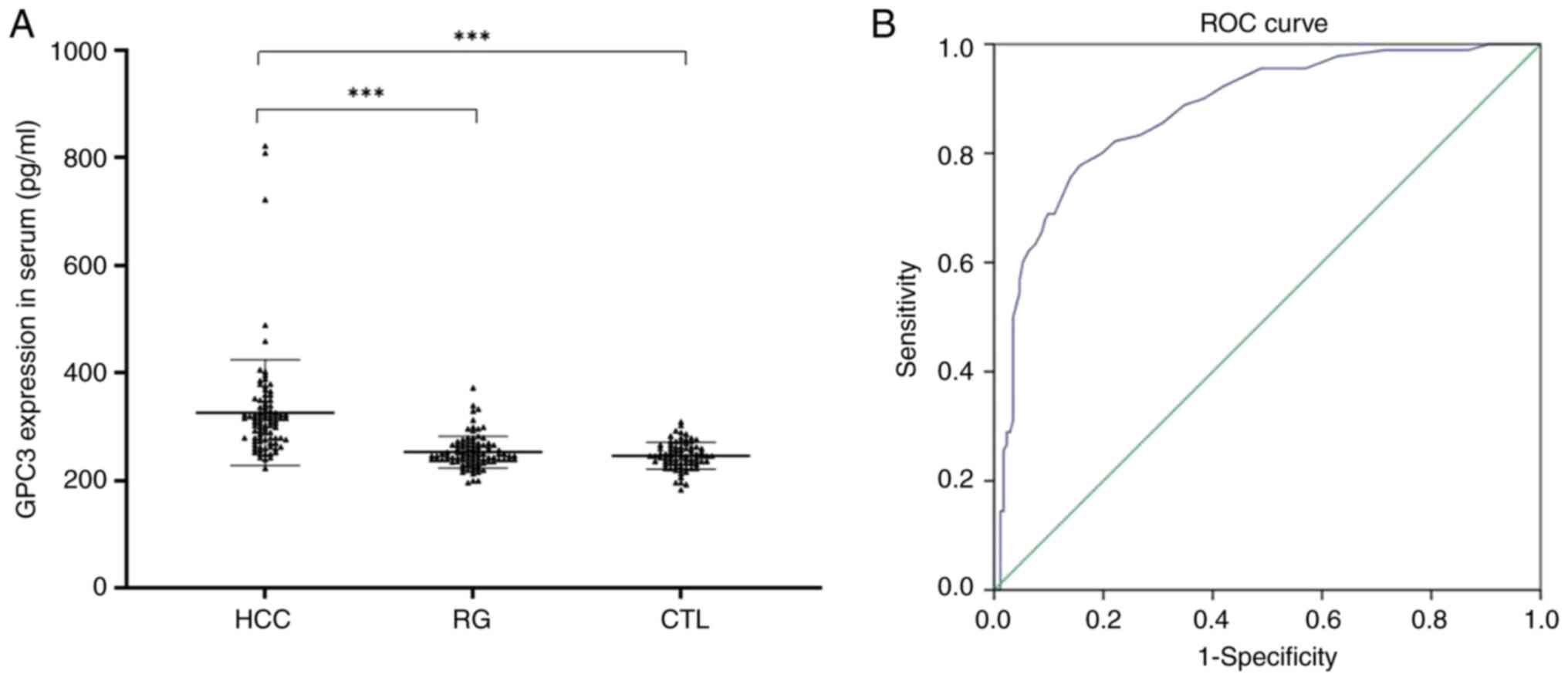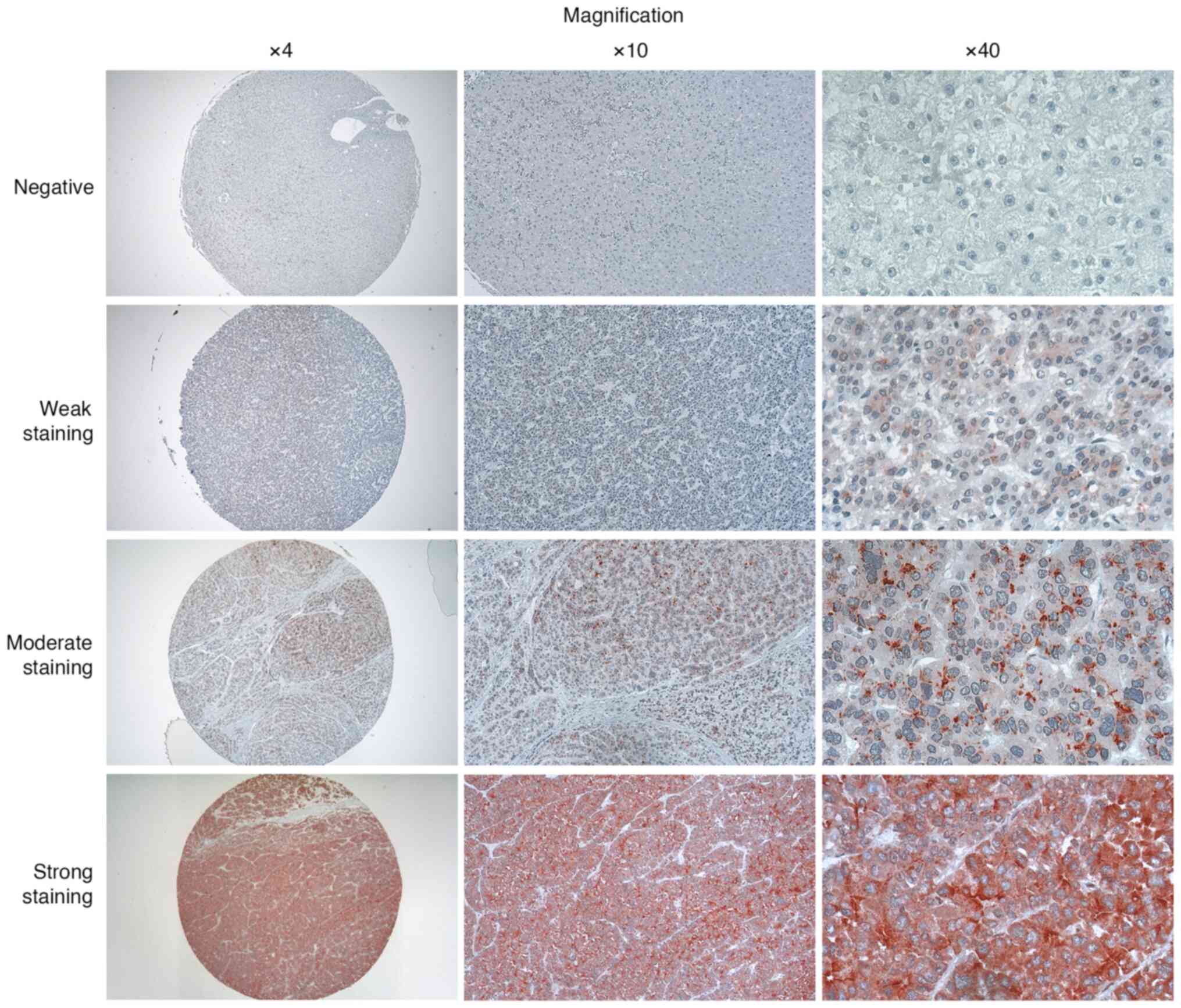|
1
|
Sung H, Ferlay J, Siegel RL, Laversanne M,
Soerjomataram I, Jemal A and Bray F: Global Cancer Statistics 2020:
GLOBOCAN estimates of incidence and mortality worldwide for 36
cancers in 185 countries. CA Cancer J Clin. 71:209–249.
2021.PubMed/NCBI View Article : Google Scholar
|
|
2
|
Wang T and Zhang KH: New blood biomarkers
for the diagnosis of AFP-Negative hepatocellular carcinoma. Front
Oncol. 10(1316)2020.PubMed/NCBI View Article : Google Scholar
|
|
3
|
Gupta S, Bent S and Kohlwes J: Test
characteristics of α-fetoprotein for detecting hepatocellular
carcinoma in patients with hepatitis C: A systematic review and
critical analysis. Ann Intern Med. 139:46–50. 2003.PubMed/NCBI View Article : Google Scholar
|
|
4
|
European Association for the Study of the
Liver. Electronic address; easloffice@easloffice.eu; European
Association for the Study of the Liver. EASL clinical practice
guidelines: Management of hepatocellular carcinoma. J Hepatol.
69:182–236. 2018.PubMed/NCBI View Article : Google Scholar
|
|
5
|
Omata M, Cheng AL, Kokudo N, Kudo M, Lee
JM, Jia J, Tateishi R, Han KH, Chawla YK, Shiina S, et al:
Asia-Pacific clinical practice guidelines on the management of
hepatocellular carcinoma: A 2017 update. Hepatol Int. 11:317–370.
2017.PubMed/NCBI View Article : Google Scholar
|
|
6
|
Zhou J, Sun HC, Wang Z, Cong WM, Wang JH,
Zeng MS, Yang JM, Bie P, Liu LX, Wen TF, et al: Guidelines for
diagnosis and treatment of primary liver cancer in China (2017
Edition). Liver Cancer. 7:235–260. 2018.PubMed/NCBI View Article : Google Scholar
|
|
7
|
Mansouri V, Razzaghi M, Nikzamir A,
Ahmadzadeh A, Iranshahi M, Haghazali M and Hamdieh M: Assessment of
liver cancer biomarkers. Gastroenterol Hepatol Bed Bench. 13 (Suppl
1):S29–S39. 2020.PubMed/NCBI
|
|
8
|
Ye L, Li D, Chen Y and Yu X: Evaluation
for clinical and prognostic implications of glypican-3 and
α-fetoprotein in hepatocellular carcinoma: A new subtype? Transl
Cancer Res. 9:3443–3452. 2020.PubMed/NCBI View Article : Google Scholar
|
|
9
|
Xu D, Su C, Sun L, Gao Y and Li Y:
Performance of serum glypican 3 in diagnosis of hepatocellular
carcinoma: A meta-analysis. Ann Hepatol. 18:58–67. 2019.PubMed/NCBI View Article : Google Scholar
|
|
10
|
Liu H, Li P, Zhai Y, Qu CF, Zhang LJ, Tan
YF, Li N and Ding HG: Diagnostic value of glypican-3 in serum and
liver for primary hepatocellular carcinoma. World J Gastroenterol.
16:4410–4415. 2010.PubMed/NCBI View Article : Google Scholar
|
|
11
|
Liu S, Wang M, Zheng C, Zhong Q, Shi Y and
Han X: Diagnostic value of serum glypican-3 alone and in
combination with AFP as an aid in the diagnosis of liver cancer.
Clin Biochem. 79:54–60. 2020.PubMed/NCBI View Article : Google Scholar
|
|
12
|
Filmus J and Capurro M: Glypican-3: A
marker and a therapeutic target in hepatocellular carcinoma. FEBS
J. 280:2471–2476. 2013.PubMed/NCBI View Article : Google Scholar
|
|
13
|
Filmus J, Capurro M and Rast J: Glypicans.
Genome Biol. 9(224)2008.PubMed/NCBI View Article : Google Scholar
|
|
14
|
Iglesias BV, Centeno G, Pascuccelli H,
Ward F, Peters MG, Filmus J, Puricelli L and de Kier Joffé EB:
Expression pattern of glypican-3 (GPC3) during human embryonic and
fetal development. Histol Histopathol. 23:1333–1340.
2008.PubMed/NCBI View Article : Google Scholar
|
|
15
|
Paine-Saunders S, Viviano BL, Zupicich J,
Skarnes WC and Saunders S: Glypican-3 controls cellular responses
to Bmp4 in limb patterning and skeletal development. Dev Biol.
225:179–187. 2000.PubMed/NCBI View Article : Google Scholar
|
|
16
|
Capurro MI, Xu P, Shi W, Li F, Jia A and
Filmus J: Glypican-3 inhibits Hedgehog signaling during development
by competing with patched for Hedgehog binding. Dev Cell.
14:700–711. 2008.PubMed/NCBI View Article : Google Scholar
|
|
17
|
Midorikawa Y, Ishikawa S, Iwanari H,
Imamura T, Sakamoto H, Miyazono K, Kodama T, Makuuchi M and
Aburatani H: Glypican-3, overexpressed in hepatocellular carcinoma,
modulates FGF2 and BMP-7 signaling. Int J Cancer. 103:455–465.
2003.PubMed/NCBI View Article : Google Scholar
|
|
18
|
Zhu ZW, Friess H, Wang L, Abou-Shady M,
Zimmermann A, Lander AD, Korc M, Kleeff J and Büchler MW: Enhanced
glypican-3 expression differentiates the majority of hepatocellular
carcinomas from benign hepatic disorders. Gut. 48:558–564.
2001.PubMed/NCBI View Article : Google Scholar
|
|
19
|
Lin Q, Xiong LW, Pan XF, Gen JF, Bao GL,
Sha HF, Feng JX, Ji CY and Chen M: Expression of GPC3 protein and
its significance in lung squamous cell carcinoma. Med Oncol.
29:663–669. 2012.PubMed/NCBI View Article : Google Scholar
|
|
20
|
Ushiku T, Uozaki H, Shinozaki A, Ota S,
Matsuzaka K, Nomura S, Kaminishi M, Aburatani H, Kodama T and
Fukayama M: Glypican 3-expressing gastric carcinoma: Distinct
subgroup unifying hepatoid, clear-cell, and
alpha-fetoprotein-producing gastric carcinomas. Cancer Sci.
100:626–632. 2009.PubMed/NCBI View Article : Google Scholar
|
|
21
|
Ofuji K, Saito K, Suzuki S, Shimomura M,
Shirakawa H, Nobuoka D, Sawada Y, Yoshimura M, Tsuchiya N,
Takahashi M, et al: Perioperative plasma glypican-3 level may
enable prediction of the risk of recurrence after surgery in
patients with stage I hepatocellular carcinoma. Oncotarget.
8:37835–37844. 2017.PubMed/NCBI View Article : Google Scholar
|
|
22
|
Haruyama Y and Kataoka H: Glypican-3 is a
prognostic factor and an immunotherapeutic target in hepatocellular
carcinoma. World J Gastroenterol. 22:275–283. 2016.PubMed/NCBI View Article : Google Scholar
|
|
23
|
Kaseb AO, Hassan M, Lacin S, Abdel-Wahab
R, Amin HM, Shalaby A, Wolff RA, Yao J, Rashid A, Vennapusa B, et
al: Evaluating clinical and prognostic implications of Glypican-3
in hepatocellular carcinoma. Oncotarget. 7:69916–69926.
2016.PubMed/NCBI View Article : Google Scholar
|
|
24
|
Zhang J, Zhang M, Ma H, Song X, He L, Ye X
and Li X: Overexpression of glypican-3 is a predictor of poor
prognosis in hepatocellular carcinoma: An updated meta-analysis.
Medicine (Baltimore). 97(e11130)2018.PubMed/NCBI View Article : Google Scholar
|
|
25
|
Kawaida M, Yamazaki K, Tsujikawa H, Fukuma
M, Abe Y, Kitago M, Shinoda M, Kitagawa Y and Sakamoto M: Diffuse
and canalicular patterns of glypican-3 expression reflect
malignancy of hepatocellular carcinoma. Pathol Int. 69:125–134.
2019.PubMed/NCBI View Article : Google Scholar
|
|
26
|
Okuda H, Nakanishi T, Takatsu K, Saito A,
Hayashi N, Takasaki K, Takenami K, Yamamoto M and Nakano M: Serum
levels of des-gamma-carboxy prothrombin measured using the revised
enzyme immunoassay kit with increased sensitivity in relation to
clinicopathologic features of solitary hepatocellular carcinoma.
Cancer. 88:544–549. 2000.PubMed/NCBI
|
|
27
|
National Comprehensive Cancer Network
(NCCN) Hepatobiliary Cancers v05.2020. Available from: https://www.nccn.org/professionals/physician_gls/pdf/hepatobiliary.pdf.
Accessed December 21, 2020.
|
|
28
|
Amin MB, Greene FL, Edge SB, Compton CC,
Gershenwald JE, Brookland RK, Meyer L, Gress DM, Byrd DR and
Winchester DP: The Eighth Edition AJCC Cancer Staging Manual:
Continuing to build a bridge from a population-based to a more
‘personalized’ approach to cancer staging. CA Cancer J Clin.
67:93–99. 2017.PubMed/NCBI View Article : Google Scholar
|
|
29
|
Capurro M, Wanless IR, Sherman M, Deboer
G, Shi W, Miyoshi E and Filmus J: Glypican-3: A novel serum and
histochemical marker for hepatocellular carcinoma.
Gastroenterology. 125:89–97. 2003.PubMed/NCBI View Article : Google Scholar
|
|
30
|
Chen M, Li G, Yan J, Lu X, Cui J, Ni Z,
Cheng W, Qian G, Zhang J and Tu H: Reevaluation of glypican-3 as a
serological marker for hepatocellular carcinoma. Clin Chim Acta.
423:105–111. 2013.PubMed/NCBI View Article : Google Scholar
|
|
31
|
Baatarkhuu O1, Malov SI, Rasulov RI,
Dvornichenko VV, Savilov ED, Malov IV and Yushchuk ND:
Hepatocellular carcinoma associated with hepatitis B and C in
mongoloids and caucasians of North-East Asia. Infectious Diseases:
News, Opinions, Training. 4:38–44. 2021.
|
|
32
|
Qiao SS, Cui ZQ, Gong L, Han H, Chen PC,
Guo LM, Yu X, Wei YH, Ha SA, Kim JW, et al: Simultaneous
measurements of serum AFP, GPC-3 and HCCR for diagnosing
hepatocellular carcinoma. Hepatogastroenterology. 58:1718–1724.
2011.PubMed/NCBI View
Article : Google Scholar
|
|
33
|
Hippo Y, Watanabe K, Watanabe A,
Midorikawa Y, Yamamoto S, Ihara S, Tokita S, Iwanari H, Ito Y,
Nakano K, et al: Identification of soluble NH2-terminal fragment of
glypican-3 as a serological marker for early-stage hepatocellular
carcinoma. Cancer Res. 64:2418–2423. 2004.PubMed/NCBI View Article : Google Scholar
|
|
34
|
Libbrecht L, Severi T, Cassiman D, Vander
Borght S, Pirenne J, Nevens F, Verslype C, van Pelt J and Roskams
T: Glypican-3 expression distinguishes small hepatocellular
carcinomas from cirrhosis, dysplastic nodules, and focal nodular
hyperplasia-like nodules. Am J Surg Pathol. 30:1405–1411.
2006.PubMed/NCBI View Article : Google Scholar
|
|
35
|
Shafizadeh N, Ferrell LD and Kakar S:
Utility and limitations of glypican-3 expression for the diagnosis
of hepatocellular carcinoma at both ends of the differentiation
spectrum. Mod Pathol. 21:1011–1018. 2008.PubMed/NCBI View Article : Google Scholar
|
|
36
|
Ligato S, Mandich D and Cartun RW: Utility
of glypican-3 in differentiating hepatocellular carcinoma from
other primary and metastatic lesions in FNA of the liver: An
immunocytochemical study. Mod Pathol. 21:626–631. 2008.PubMed/NCBI View Article : Google Scholar
|
|
37
|
Coston WM, Loera S, Lau SK, Ishizawa S,
Jiang Z, Wu CL, Yen Y, Weiss LM and Chu PG: Distinction of
hepatocellular carcinoma from benign hepatic mimickers using
Glypican-3 and CD34 immunohistochemistry. Am J Surg Pathol.
32:433–444. 2008.PubMed/NCBI View Article : Google Scholar
|
|
38
|
Baumhoer D, Tornillo L, Stadlmann S,
Roncalli M, Diamantis EK and Terracciano LM: Glypican 3 expression
in human nonneoplastic, preneoplastic, and neoplastic tissues: A
tissue microarray analysis of 4,387 tissue samples. Am J Clin
Pathol. 129:899–906. 2018.PubMed/NCBI View Article : Google Scholar
|
|
39
|
Tátrai P, Somorácz Á, Batmunkh E,
Schirmacher P, Kiss A, Schaff Z, Nagy P and Kovalszky I: Agrin and
CD34 immunohistochemistry for the discrimination of benign versus
malignant hepatocellular lesions. Am J Surg Pathol. 33:874–885.
2009.PubMed/NCBI View Article : Google Scholar
|
|
40
|
Anatelli F, Chuang ST, Yang XJ and Wang
HL: Value of glypican 3 immunostaining in the diagnosis of
hepatocellular carcinoma on needle biopsy. Am J Clin Pathol.
130:219–223. 2008.PubMed/NCBI View Article : Google Scholar
|
|
41
|
Yan B, Wei JJ, Qian YM, Zhao XL, Zhang WW,
Xu AM and Zhang SH: Expression and clinicopathologic significance
of glypican 3 in hepatocellular carcinoma. Ann Diagn Pathol.
15:162–169. 2011.PubMed/NCBI View Article : Google Scholar
|
|
42
|
Ning S, Bin C, Na H, Peng S, Yi D,
Xiang-hua Y, Fang-yin Z, Da-yong Z and Rong-cheng L: Glypican-3, a
novel prognostic marker of hepatocellular cancer, is related with
postoperative metastasis and recurrence in hepatocellular cancer
patients. Mol Biol Rep. 39:351–357. 2012.PubMed/NCBI View Article : Google Scholar
|
|
43
|
Li B, Liu H, Shang HW, Li P, Li N and Ding
HG: Diagnostic value of glypican-3 in alpha fetoprotein negative
hepatocellular carcinoma patients. Afr Health Sci. 13:703–709.
2013.PubMed/NCBI View Article : Google Scholar
|














